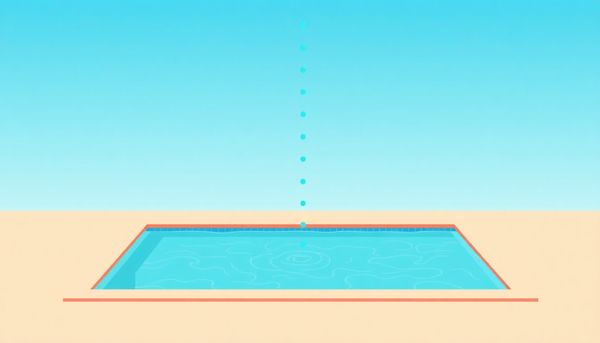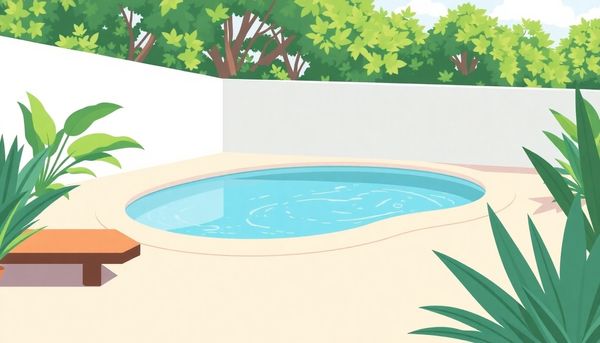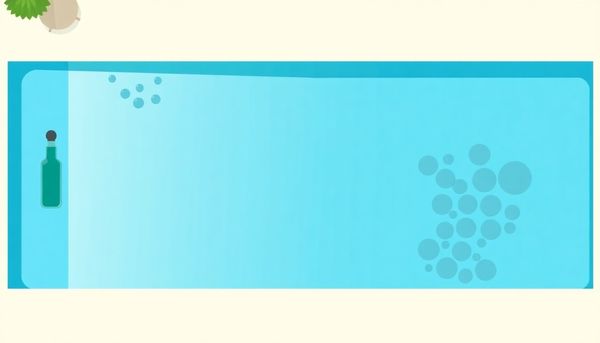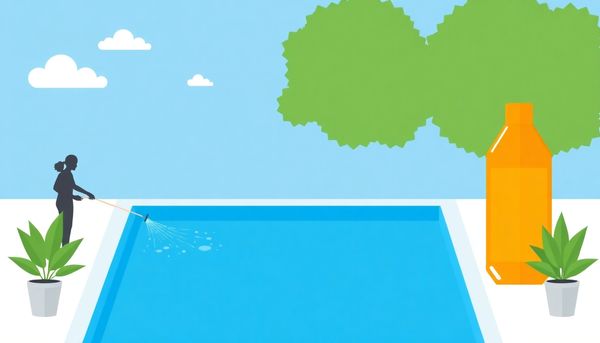Clear Cloudy Pool Water: Flocculant vs. Clarifier Explained
September 11th, 2024
September 11th, 2024
The serene blue of a swimming pool is inviting, but sometimes unexpected cloudiness can transform it into a murky mystery. Those who cherish their time by the poolside know the importance of keeping the water crystal clear. When clarity slips through the cracks, though, it’s time to delve into solutions like pool flocculants and clarifiers. These aren't just fancy words thrown around in pool maintenance circles; they are essential tools for anyone looking to restore their pool's sparkle.
On a sunny weekend, my neighbor found himself peering into his pool, puzzled by its sudden haze. After a thorough chat, we discovered the concept of flocculants—a magic powder, in layman's terms, that clumps together all those pesky particles clouding the water. By forming larger clusters, these particles can then be easily removed, leaving the water looking pristine. Pool clarifiers, on the other hand, work more subtly, enhancing the pool's filtration system to trap tiny particles without the dramatic clumping action.
Each method has its nuances, and deciding between them often hinges on urgency and desired outcomes. While both aim for clarity, the paths they take differ significantly. By understanding these options, pool owners can make informed decisions, ensuring their aquatic retreats remain as inviting as ever, come sweltering summer or the refreshing chill of autumn days.

Choosing the right pool flocculant can be the key to transforming murky waters into crystal-clear delights swiftly. Unlike clarifiers, which take a more leisurely approach, flocculants offer a rapid solution when time is of the essence. If you're preparing for an upcoming gathering or simply can't stand the sight of a foggy pool, a flocculant works wonders by clumping together pesky small particles that cloud your water. These dense clumps, once formed, settle at the bottom, ready to be vacuumed out with ease.
When my neighbor was gearing up to host a barbecue, she panicked at the sight of her cloudy pool. I suggested using a flocculant, and we set about applying it according to the instructions. The process was straightforward: recirculating the flocculant throughout the pool, letting it sit undisturbed overnight, and then vacuuming up the settled debris the next morning. By the time her guests arrived, the pool sparkled invitingly, a testament to the flocculant's effectiveness.
Consider your pool's setup before reaching for the flocculant. Ensure your filter has a "waste" setting to avoid clogging, as flocculant requires bypassing the filter for removal. This method does involve some manual labor, but the reward is swift and impressive clarity. For those who face frequent cloudiness, a flocculant is a reliable ally in maintaining aquatic allure.
Choosing between a pool flocculant and a pool clarifier can feel like picking between two similar-looking roads on a map. Both aim to clear your water, yet the journey they take is quite different. When your pool resembles more of a milky lagoon than a sparkling oasis, a flocculant acts quickly, similar to an emergency cleanup crew. It clusters the pesky particles together, creating heavier clumps that gracefully sink to the pool's floor, ready for vacuuming. This process is ideal for those last-minute pool parties, but it demands a hands-on approach, including a thorough manual vacuum session.
In contrast, a clarifier operates with a more laid-back tempo. It gently nudges the fine particles towards your filter, which does the heavy lifting over a longer period. This method is perfect when your pool is only slightly cloudy and you prefer a low-maintenance solution. It lets you maintain your regular routine without the urgency of removing clumps manually. However, patience is key, as clarifiers might take a few days to exhibit visible results.
From personal experience, when a summer storm left my pool looking like a foggy pond, the immediate impact of a flocculant was unmatched. Yet, for minor clarity touch-ups post-season, a clarifier seamlessly blended into my weekly pool care schedule. Ultimately, the choice hinges on how quickly you need clear waters and how much effort you're willing to put forth.
Handling pool flocculant with care is paramount, like preparing a fine dish where each ingredient plays a crucial role. The first step towards success is to ensure your pool's pH levels are within the ideal range of 7.4 to 7.6; think of it as setting the stage perfectly before the main act begins. Testing and adjusting the pool's pH with the right increaser or decreaser sets the groundwork for the flocculant to effectively bind those pesky particles.
Before adding the flocculant, it's essential to adjust your pool filter to "recirculate." This prevents any clogs in the filtration system, saving you from potential headaches. Imagine having to replace the filter medium because it got all gummed up—not a fun scenario! As you pour in the flocculant, carefully follow the dosage instructions depending on your pool's size. Using a pool volume calculator can be a handy tool if you're unsure.
Once the flocculant is in, keep the pump running for a couple of hours to ensure even distribution, then let it rest overnight. The next morning, you'll find the clumped particles resting at the bottom. Vacuuming these out requires patience; move deliberately to avoid stirring up the settled debris. Should your water level drop post-vacuuming, a simple garden hose with a filter can efficiently restore it. Finally, recalibrate your pool’s chemical balance, ensuring everything is back to its crystal-clear glory. This method, while requiring effort, rewards you with a pool that's pristine and ready for the next swim.
After successfully clearing your pool with flocculant, the process isn't quite over. The balance of your pool's chemistry might have shifted, and it's essential to restore it to optimal levels. You might recall a time when you were cooking and accidentally added too much salt; adjusting pool chemistry is a bit like correcting that dish. Start by checking the alkalinity and pH levels. Ideally, the pH should sit comfortably between 7.4 and 7.6. If adjustments are necessary, use a pH increaser or decreaser to nudge it back into range.
Next, focus on the chlorine levels. The vacuuming process often lowers chlorine, so it's crucial to replenish it, ensuring your pool remains sanitized and free from potential bacterial growth. Running your filter system normally at this stage will help evenly distribute the chemicals, promoting a balanced environment throughout.
Don't forget about the water level. Vacuuming to waste inevitably reduces it, so top off the pool with fresh water. As you refill, consider using a garden hose with a pre-filter to prevent introducing unwanted impurities. Once refilled, test your water once more to confirm everything is back in harmony.
Adjusting pool chemistry might seem tedious, but think of it as setting the stage for a summer of perfect swims. With everything balanced, you're not just maintaining a pool; you're ensuring a clean, welcoming oasis for all your aquatic adventures.

Navigating the world of pool maintenance can sometimes feel like learning a new language, especially when it comes to choosing between flocculant and clarifier. Both tools serve the purpose of clearing up cloudy water, but the paths they take are quite distinct.
Flocculant acts swiftly, gathering minuscule particles into heavy clumps that settle at the pool's bottom. This method is great for urgent clean-ups or after a heavy storm leaves your pool murky. However, it requires a bit of elbow grease, as those clumps must be manually vacuumed out. I remember a time when my pool looked like a swamp just before a summer barbecue. A quick application of floc and an evening of vacuuming transformed it into a sparkling oasis just in time.
Clarifiers take a subtler approach. They bind particles into smaller clusters, which are then filtered out naturally, akin to how a good tea infuser works. This process is simpler and less labor-intensive but demands patience, as it might take a few days to see the clear results. For pools with mild cloudiness, or if your schedule doesn’t allow for extensive manual labor, a clarifier is the way to go. My neighbor swears by it, preferring the set-and-forget convenience over the intensive clean-up operation.
In essence, your choice boils down to urgency and effort. For quick results with some manual intervention, flocculant stands out. For an easy, gradual improvement, clarifier is your friend. Both have their places in the toolkit of effective pool care.
Navigating the decision between flocculant and clarifier can feel like choosing between a sprint and a marathon. Flocculant is your go-to when time is of the essence and your pool resembles a foggy morning more than a sparkling oasis. It excels in swiftly binding together tiny particles into dense, removable clumps. Before your next backyard bash, when a fast turnaround is essential, flocculant can save the day by making murky water clear in as little as one or two days.
However, it's not always the right tool for the job. Flocculant demands a bit more elbow grease, requiring a manual vacuum to remove the settled debris. Opt for it when you have the time and resources to handle an intensive cleanup process. It's especially effective after heavy rainstorms or when early signs of algae appear, tackling the root of cloudiness rather than masking it.
In contrast, a clarifier suits those less severe cases, like slightly hazy water that needs gradual improvement. It works with any filtration system, making it a convenient option for routine maintenance. But, if a thunderstorm has played havoc with your pool's clarity or unexpected guests are on their way, reach for the flocculant. Just remember, whichever you choose, understanding your pool's specific needs will guide you to shimmering, inviting water.
Balmy afternoons by the pool can quickly lose their charm if the water turns into a murky mystery. For those times when clarity seems a distant dream, following meticulous flocculant application steps can be your ticket back to sparkling waters. Start by ensuring your pool filter is set to "recirculate"—this keeps the flocculant from clogging the system. With the pump running, add the prescribed amount of flocculant, paying close attention to the manufacturer's instructions.
The next stage involves patience. Allow the flocculant to work its magic overnight by turning off your pool pump. During this period, tiny particles coagulate and gracefully descend to the pool's floor. This is not the time for haste; instead, let gravity do the heavy lifting. Once settled, attach a manual vacuum and set your filter to "waste." Vacuuming should be deliberate and slow; rushing it may disturb the rested particles, clouding the water anew.
Once you've vacuumed thoroughly, it's time to replenish what was lost. Refill your pool to its ideal water level. With the heavy work done, it's important to turn your focus to water chemistry. Test and adjust the pool's alkalinity and pH levels, then reintroduce chlorine. As you return to regular filtration, marvel at the clear reflections dancing in the sun. While it demands more elbow grease than its clarifier counterpart, flocculant offers a satisfying payoff for those seeking pristine pool days.
Choosing between a pool flocculant and a clarifier involves understanding the unique strengths each brings to the table. Imagine you have an upcoming pool party, and your pool water has turned disappointingly murky. Here enters the hero of speed—flocculant. This chemical swoops in, rapidly gathering those pesky tiny particles into larger, sinkable clumps. With a bit of elbow grease—namely, manually vacuuming out these clumps—your pool can be sparkling clear in a day or two. However, this method requires a pool system that allows you to bypass the filter, as these hefty clumps are too substantial for it to manage.
On the flip side, if patience is on your side and the cloudiness is mild, the clarifier might be your preferred choice. It's like a gentle breeze, ushering small particles into manageable clusters that the pool filter can gradually handle. While clarifiers may take longer to achieve that crystal clarity, they require minimal intervention, making them perfect for regular pool maintenance.
Both options serve valuable roles, yet they cater to different needs. A flocculant is your best bet for quick clarity when time is of the essence. Meanwhile, the clarifier steadily works behind the scenes, keeping your water in pristine condition with less frequent hands-on effort. Balancing speed against convenience and understanding your pool's filtration setup will guide you to the right choice for each situation.

Picture a summer morning, where the only thing cloudier than the sky is your pool water. Enter the unsung hero of pool maintenance: flocculant. Known for its remarkable ability to gather minuscule particles into sizable clusters, flocculant displays its prowess by transforming seemingly murky waters into a clear, inviting oasis.
To make the most out of this chemical marvel, begin by testing your pool’s pH balance, ensuring it falls between 7.4 and 7.6. This step is crucial, as improper pH levels can hinder the flocculant’s effectiveness. Once your pool’s chemistry is in check, adjust your filter to the "recirculate" setting. This configuration prevents the flocculant from clogging your filter, a common rookie mistake.
With the groundwork laid, you can now introduce the flocculant to the water. Follow the manufacturer's guidelines to determine the appropriate amount based on your pool’s volume. After a brief two-hour circulation period, switch off the pump and let the flocculant work its magic overnight.
The following morning, you’ll wake up to find the particles have settled peacefully at the pool’s bottom, waiting to be vacuumed. Set your filter to "waste" and gently vacuum the gathered particles without stirring them. This might require a couple of attempts, so patience is key.
Finally, replenish your pool’s water level and check the chemical balance again. A well-maintained pool not only sparkles in the sun but also ensures a safe swimming environment for everyone. With a little effort and the right technique, flocculant turns your pool back into the clear, shimmering gem it should be.
Navigating the world of pool maintenance can resemble the fine art of balancing a scale. One side holds the promise of sparkling waters, while the other threatens a murky, uninviting pool. When it comes to choosing between a pool flocculant and a clarifier, understanding their distinct roles is key.
Flocculants act swiftly, ideal for situations that demand immediate attention, like an impending pool party. They operate by binding tiny particles into larger clumps that promptly settle at the pool's floor, making manual vacuuming a necessity. Although this method is labor-intensive, the reward is a crystal-clear pool surface within a day or two—a definite advantage when time is of the essence.
Conversely, clarifiers offer a more gradual approach. They gather small particles into clusters that your pool's filter system can handle over time. This method suits pools that are just slightly cloudy and don’t require urgent action. The clarifier’s gentle, less disruptive nature means less manual effort, and it can be used with any filtration system.
The decision hinges on several factors: the severity of cloudiness, how quickly you need results, and the effort you’re willing to invest. If your pool resembles a foggy lake that needs a quick fix, flocculant is your go-to. However, for everyday maintenance or minor cloudiness, a clarifier may be all you need. Balancing these choices ensures you maintain a perfect oasis, ready for a swim at any moment.
Embarking on the journey to transform murky pool water into a crystalline oasis requires the right preparation, especially when using pool flocculant. Begin by ensuring your pool is ready for this process. Take a moment to assess your pool’s current state, checking both the clarity and the chemistry. A balanced pH, ideally between 7.4 and 7.6, is crucial. If necessary, adjust it using a pH increaser or decreaser, ensuring the environment is optimal for flocculant effectiveness.
Once pH levels are set, it's time to shift your pool filter setting to "recirculate." This adjustment is vital, as it prevents the flocculant from clogging the filter, allowing it to work seamlessly throughout the water. Measure your pool's volume accurately; it’s the blueprint for determining the exact amount of flocculant needed. A pool calculator can be a handy tool here, averting any guesswork and ensuring precision.
After adding the flocculant, activate the pool pump for a couple of hours, helping the product disperse evenly. Then, switch off the pump to allow the particles to coagulate and settle overnight. This quiet period grants the flocculant the opportunity to gather debris into larger clumps, which will eventually rest at the bottom. Prepare your manual vacuum for the next day, ready to remove the settled particles. With these steps, your pool will be well on its way to regaining its inviting sparkle.
Cloudy water can be a nuisance, but there's nothing quite like the satisfaction of watching your pool transform from murky to sparkling clear. After using a pool flocculant, which lumps together fine particles into larger clumps that sink to the pool floor, the next crucial step is vacuuming. Imagine those clumps as tiny, stubborn culprits of cloudiness, now ready to be removed. Equipped with your manual vacuum, you’ll need to ensure your pool’s filter is set to “waste” mode. This setting allows the water, along with the unwanted debris, to bypass the filter and leave your pool entirely, preventing any potential clogging.
As you gently guide the vacuum across the pool floor, it's important to move slowly. Swift motions can stir up the particles, undoing some of your hard work. Be patient; sometimes, a couple of passes are necessary to capture every last bit of debris.
Once the vacuuming is complete, your pool’s water level might drop. A simple garden hose can help to restore the water level. Just remember, rebalancing the pool’s chemistry is essential after this process. Use water testing kits to check and adjust pH, alkalinity, and chlorine levels. Proper chemical balance not only ensures a clear pool but also prevents future cloudiness, allowing you to enjoy the shimmering water without hassle.

Battling murky pool water can feel like an unwelcome summer guest overstaying its welcome. When the usual maintenance doesn’t cut it, pool flocculant becomes a trusty ally. In essence, flocculant is your pool's secret weapon, transforming tiny, pesky particles into larger clumps that conveniently settle at the pool’s floor, ready for vacuuming. Unlike clarifiers, which work slowly and steadily through the filtration system, flocculant acts swiftly, making it the go-to solution for rapid clarity restoration.
Years ago, I remember a neighbor's pool party being saved by this very trick. The day before, a storm had left their pool looking more like a swamp. Flocculant was added overnight, and by morning, the water was clear enough to reflect the bright summer sky, thanks to a few rounds of careful vacuuming. This quick fix, however, requires some manual labor, as the clumped particles need to be vacuumed out manually, bypassing the filter entirely.
Timing and preparation are crucial. Ensure your filter system can handle the waste setting, and always check your pool’s pH levels before you start. And remember, moderation is key; too much flocculant can cloud your water further. With a little effort, flocculant can turn your cloudy pool into a sparkling oasis, ready for any impromptu gathering or a quiet day of relaxation.
Navigating the choice between pool flocculant and pool clarifier can feel a bit like deciding between a quick sprint and a leisurely jog. Each has its place, and understanding when to use them can save you time and effort. Flocculant excels in urgent situations—think of it as your emergency lifeline for a last-minute pool party. It rapidly gathers those pesky particles, dragging them to the pool floor where they can be easily vacuumed away. However, it requires a bit of elbow grease, precise setup, and the right equipment, such as a multiport valve to bypass the filter.
On the other hand, a clarifier might be your best bet if you’re dealing with minor cloudiness and prefer a hassle-free approach. This option is less demanding, allowing your pool filter to do the heavy lifting as smaller clumps are filtered out over time. Although this method takes longer, it’s perfect for regular maintenance when you’re not in a rush.
Reflect on your pool’s condition and your available time. If you find yourself repeatedly fighting cloudy water, a closer look at your pool’s water chemistry might reveal underlying issues. Balancing pH and regularly cleaning filters can often prevent recurring problems. Ultimately, choosing the right treatment involves aligning your immediate needs with the maintenance routine that best suits your lifestyle and pool setup.
Making the most of pool flocculant involves a careful balance of preparation, chemistry, and patience. Start by ensuring your pool's pH level sits snugly between 7.4 and 7.6. This sweet spot allows the flocculant to perform its magic effectively. It might remind you of baking a cake—where exact measurements and conditions make all the difference.
Before mixing in the flocculant, switch your filter setting to "recirculate" to prevent clumps from clogging the filter. Once added, let the pump run for about two hours. It’s like marinating a good steak—the longer you let it sit, the better the results. Afterwards, turn off the pump and let the pool rest undisturbed for at least eight hours, preferably overnight. Picture this as letting the flocculant host its own tiny gravity party, pulling particles down to the pool bottom.
Now comes the part where muscle meets mindfulness: vacuuming. Set your filter to "waste" and get ready to manually vacuum out the flocculated particles. Move slowly to avoid stirring up the settled particles—think of it like tiptoeing on a creaky floor. If you find murkiness returning, take a breather and let things settle before resuming.
After vacuuming, you’ll likely need to top up the water level. Use a garden hose equipped with a filter to maintain clarity. Lastly, don’t forget to rebalance your pool’s water chemistry, paying special attention to alkalinity and chlorine levels. This ensures not just a clear pool, but a healthy one too. It’s akin to giving your pool a restorative spa day after a deep clean.
When tackling cloudy pool water, maintaining balanced water chemistry becomes an unsung hero. While flocculants and clarifiers offer quick fixes, they work optimally only when your pool's chemistry is in harmony. Think of your pool as a delicate ecosystem; a slight imbalance in pH or alkalinity can throw everything off-kilter. A pH level between 7.4 and 7.6 forms the sweet spot where flocculants perform their best magic.
Testing your water levels is more than just a routine check—it’s about creating a stable environment where every chemical added can perform its intended function. I recall a time when my pool was persistently murky despite repeated dosing with flocculant. A simple pH adjustment transformed the water clarity dramatically, reminding me of the power of well-balanced chemistry.
Beyond pH, ensure your pool's alkalinity hovers between 80 to 120 ppm. This range acts like a buffer, preventing sudden pH fluctuations that could undermine the effectiveness of flocculants. Don't overlook calcium hardness either; while it doesn’t directly impact flocculation, it ensures your water doesn't turn aggressive towards pool surfaces.
After using flocculants, you've likely vacuumed out a significant amount of water, taking with it the balanced chemistry you initially set. This step is your cue to re-test and adjust the fundamentals—pH, alkalinity, and chlorine levels. By paying attention to these details, your pool remains not just clear, but a joy to swim in, free from irritation and potential harm.

Achieving crystal-clear pool water isn’t just about quick fixes; it begins with the fundamental step of balancing pool chemistry. This crucial foundation ensures that any treatment, such as using a pool flocculant, is effective. Think of it like ensuring the soil is fertile before planting—you want to give your solution the best chance to flourish.
For starters, a balanced pH is essential. A pH range of 7.4 to 7.6 is ideal because it creates an environment where both chlorine efficiency and swimmer comfort are optimized. If the pH level is too high or too low, it can hinder the effectiveness of the flocculant, leaving your pool water still cloudy. Adjustments can be made using a pH increaser or decreaser based on your pool's needs.
Beyond pH, the total alkalinity should be in check, typically between 80 to 120 ppm. This not only stabilizes pH levels but also prevents corrosion and scaling in your pool. Also, proper chlorine levels are key to eliminating bacteria and algae, paving the way for flocculants to focus on clearing up those stubborn particles.
Once you’ve nailed down your pool's chemistry, you set the stage for the flocculant to perform its magic. It’s akin to laying down a solid track before a race—the vehicle of your choice, in this case, the flocculant, can then do its job with maximum efficiency and minimum hiccups.
Selecting the proper treatment for cloudy pool water can feel like navigating a maze, but understanding your options simplifies the process. Flocculant and clarifier each serve distinct purposes, much like choosing between a quick sprint or a steady marathon. Flocculant is your go-to for rapid results. It acts swiftly by binding minuscule particles into larger clumps that sink to the pool floor. This method requires manual vacuuming, which can be labor-intensive but invaluable for those urgent clear-ups, such as before a weekend gathering.
On the other hand, pool clarifier offers a more gradual approach. It’s the laid-back cousin in water treatment; it gathers particles into smaller clusters that the filter can tackle gradually. Though less immediate than flocculant, clarifier demands less hands-on work, making it suitable for routine maintenance when time isn't of the essence.
Consider your pool’s condition. If a sudden storm has transformed your crystal-clear oasis into a murky nightmare, flocculant might be your best ally. However, for slight cloudiness or maintenance during the swimming season, clarifier suffices. Don't forget to check your pool’s filtration capabilities; some setups may not accommodate the demands of flocculant use. With these insights, you can confidently choose the solution that aligns with your needs, ensuring your pool remains a sparkling centerpiece.
Balancing the pH levels of your pool is much like crafting the perfect recipe; both require precision and a little bit of patience. The right pH range for a pool when using flocculant sits comfortably between 7.4 and 7.6. This range not only enhances the effectiveness of flocculant but also ensures a safe swimming environment. The reason? Outside this range, flocculant might not clump particles as effectively, leaving your water still cloudy.
Imagine you're hosting a pool party; the last-minute scramble is real. You test the water, and the pH reads 7.2. Panic? Not necessary. A pH increaser, typically sodium carbonate, can nudge those numbers up. Conversely, if the pH is above 7.6, a pH decreaser, often sodium bisulfate, will bring it back to balance. It’s like adjusting seasoning in a dish until it’s just right.
Personal anecdotes can illustrate the importance of this step. I recall a friend who skipped this crucial task, assuming flocculant could work its magic under any condition. The result? A murky pool and a frustrated Saturday afternoon spent vacuuming without success. Learning from others’ missteps, we can appreciate that optimizing pH is not just a fancy extra but a fundamental step in the grand choreography of pool care. So, always test, adjust, and then proceed with confidence.

This article provided insights into maintaining your pool. Start your pool care journey today!
Want to become a pool maintenance expert? Our free Pool School course covers everything you need to know about pool care. From basic maintenance to advanced troubleshooting, you'll learn how to:
Join over 10,000 pool owners who have already transformed their pool care routine. Get started with our free Pool School course today!